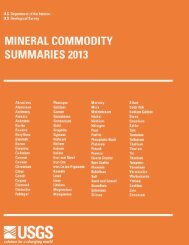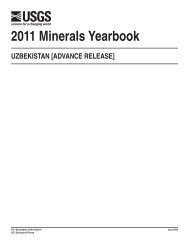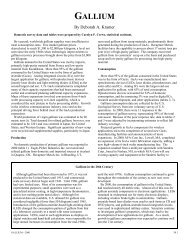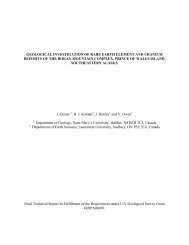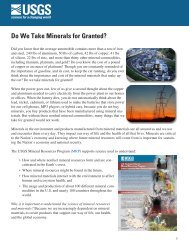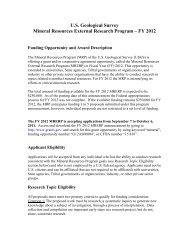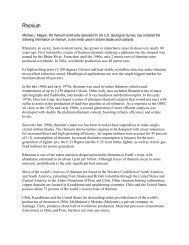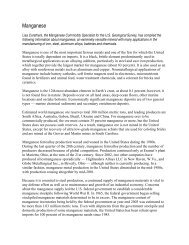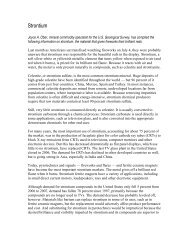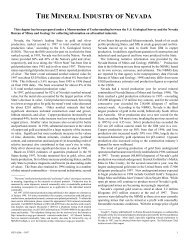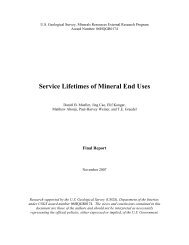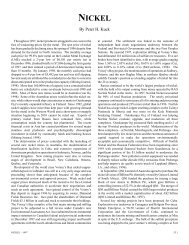Mineral Commodity Summaries 2003 - Mineral Resources Program ...
Mineral Commodity Summaries 2003 - Mineral Resources Program ...
Mineral Commodity Summaries 2003 - Mineral Resources Program ...
You also want an ePaper? Increase the reach of your titles
YUMPU automatically turns print PDFs into web optimized ePapers that Google loves.
INDIUM<br />
Events, Trends, and Issues: Estimated domestic indium consumption increased by about 15% to 75 metric tons in<br />
2002. After 3 years of relative stability, the annual average price of indium dropped considerably in 2000 and 2001<br />
and then increased slightly in 2002. Expanding LCD manufacture kept demand strong for indium-tin oxide, and the<br />
use of indium phosphide for semiconductors could increase worldwide demand for indium. The ready availability of<br />
low-priced indium from China—with increases in capacity, production, and purity—kept world prices down. The long<br />
range outlook for the indium market remains promising despite possible near term market fluctuations caused by<br />
economic uncertainties.<br />
World Refinery Production, Reserves, and Reserve Base:<br />
Refinery production e<br />
Reserves 3<br />
Reserve base 3<br />
2001 2002<br />
United States — — 300 600<br />
Belgium 40 40 ( 4 ) ( 4 )<br />
Canada 45 45 700 2,000<br />
China 100 85 280 1,300<br />
France 65 65 ( 4 ) ( 4 )<br />
Japan 55 60 100 150<br />
Peru 5 5 100 150<br />
Russia 15 15 200 300<br />
Other countries 20 20 800 1,500<br />
World total (may be rounded) 345 335 2,500 6,000<br />
World <strong>Resources</strong>: Indium occurs predominantly in solid solution in sphalerite, a zinc-sulfide ore mineral. Large<br />
quantities of indium also are contained in ores of copper, lead, and tin, but there is not enough information to formulate<br />
reliable estimates of indium resources, and most of these deposits are subeconomic for indium. Indium is recovered<br />
almost exclusively as a byproduct of zinc. Estimates of the average indium content of the Earth’s crust range from 50<br />
to 200 parts per billion. The average indium content of zinc deposits ranges from less than 1 part per million to 100<br />
parts per million. The highest known concentrations of indium occur in vein or replacement sulfide deposits, usually<br />
associated with tin-bearing minerals. However, this type of deposit is usually difficult to process economically.<br />
Substitutes: Gallium arsenide can substitute for indium phosphide in solar cells and semiconductor applications.<br />
Silver-zinc oxide or tin oxide are lower cost substitutes for indium-tin oxide in transparent conductive coatings for<br />
glass. Hafnium can replace indium alloys for use in nuclear reactor control rods.<br />
e<br />
Estimated. NA Not available. — Zero.<br />
1<br />
Prepared by Jozef Plachy.<br />
2<br />
Defined as imports - exports + adjustments for Government and industry stock changes; exports were assumed to be no greater than the<br />
difference between imports and consumption.<br />
3 Estimate based on the indium content of zinc ores. See Appendix C for definitions.<br />
4 Reserves and reserve base for this country and other European nations are included with “Other countries.”<br />
U.S. Geological Survey, <strong>Mineral</strong> <strong>Commodity</strong> <strong>Summaries</strong>, January <strong>2003</strong><br />
83



